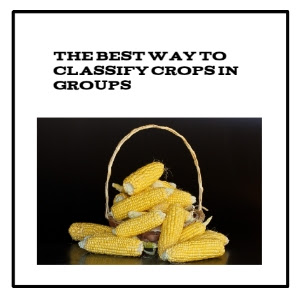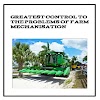(a) classification based on their life cycle
(b) classification based of their uses
Classifying Crops based on their Life Cycle
In this classifying of crops based on their life1. Annual Crops
2. Biennial Crops
3. Perennial Crops
Annual Crops - These crops are planted , grown and get matured within a period of one year e.g maize, rice, cowpea,millet , cotton, groundnut, vegetables etc
Biennial Crops - These crops are planted and mature within two years, e.g pepper, ginger and cassava.
Perennial Crops - These are crops that are planted and get matured I more than three years e.g cocoa,banana, oranges, mango ,oil palm , rubber etc.
Classification of Crops based on their uses
In this classification of Crops based on their uses can be divided into the following1. Cereal Crops
2. Pulses( grains legumes)
3. Root and tuber crops
4. Vegetables Crops
5. Fruit crops
6. Beverages Crops
7. Spices
8. Oil Crops
9. Fibre Crops
10. Latex Crops
Cereal Crops - These are crops that belongs to the grass family and provides carbohydrates for the body examples include ; wheat, barley, rice, maize.
Pulses (grains legumes) - These crops are leguminous crops which are highly proteinous e.g cowpea,soya beans, groundnut.
Roots and Tuber Crops - These crops produce tuber that is underground and they provides carbohydrates e.g cassava, carrots, sweet, cocoyam, yam etc
Vegetables Crops - These crops provides essential vitamins and minerals e.g amaranthus, onion,okra, spinach, bitter leaf.
Fruits Crops - These are crops that provides vitamins and minerals e.g oranges, pineapple,mango, pawpaw , cashew etc
Beverages Crops - These provides foods drinks when processed e.g cocoa, coffee, kolanut etc.
Spices - These crops provides vitamins and minerals.They also ass flavour to our soup e.g ginger, pepper and onion etc.
Oil Crops - These oil Crops are crops that can provide oli when processed noth for domestic and industrial uses, e.g oil palm, groundnut,melon, soyabean , cotton etc
Fibre Crops - These are crops that bare used for making clothe,clothing materials,ropes bags e.g cotton,sisal, hemp etc
Latex Crops - These crops provides some liquids that are white and sticky or latex used in plastic industries e.g rubber.
Some Cultural Practice in Crop Production
1. Transplanting - This is the transferring of seedlings from nursery bed to their permanent place.Plant is removed with some soil covering it in a ball like around it roots by using handtrowek, diggers, hoe and cutlass.The ball like soil around the root at the permanent position are firmed in order to eleminate air pockets.Transplating is done bat a very early stage of development of crop plants , long before it finally matures.Watering is done in evening and morning after the plant is transplanted.Note that weak or diseased seedlings should not be translated.2. Shading - This is the covering of the seedlings with grass.This protect seedlings from harsh external environmental conditions e.g sun and rain drops.Shadin reduces evapo- transpiration.Shades are removed progressively until they are finally dispensed.
3. Supplying/Filling-in - This is the act of replacing the seeds that fail to germinate or seedlings that eventually dies.This replacement of the dead seedlings is carried out to maintain the population of that exact plant.This process is done manually as no machine is available for it.This process is done within two weeks of the first planting to obtain a uniform growth in all plant.
4. Nursery - This is the planting of smaller or delicate seed or while which are delicate which could easy to be destroy while young requires pre-planning on a site.This is done in usually in seed boxes, bed and polypots etc. The seed planting doesn't not require much digging since its in beds which just farmers to broadcast,drill, or light cover the seed with some soil. Nursery watering done with a fine rose watering can. Nurseries are usually shaded, enclosed or fenced. All the boxes, beds, drills must be properly labelled to knows the specie of the different germinated crops.Weeding, pest and diesease are also controlled by apply fertilizers.
5. Seed Rate - This ia referred to the quantity required to plant on one hectre of land.Quantity of seeds mostly depends on spacing or population farmers wants. (e.g the seed rate of maize is 30- 34 kg per hectare).
6. Thinning - This is the process of removing weak plants from a stand which need to be supplied.This process is done to give rise to other vigorous crop plants.This is done by hand and usually practised when the crop plants are still very young.
7. Weeding - Weeding is the removal of unwanted plants which grows when not needed around cultivated crops. Every farm needs this practic as it is done regularly on farmlands in order to prevent the weed from competing with planted crops for space, sunlight, nutrients, soil moisture,oxygen and other soil nutrients. Weeding is usually done manually by hoeing, and use of cutlass etc or chemical with the use of specific herbicides, or mechanically with machine.
8. Mulching - This is the covering of herbs or ridges with dry leaves to reduce soil temperature, conserve soil moisture and prevent rottening of some crops plants, e.g yam setts.
9. Spacing - This refers to the distance within and between crop plants in a farmlands.This practice ensures the greater yield of crops and prevents overcrowding and easy ventilation between rows of crop plants.The spacing determines the seed rate.For example, the spacing for maize could be 90 cm × 30 cm at one seed hole.
10. Staking - This is process of providing stakes to certain plant or provides wood to enable the crop plant to stand erect and prevent it from lodging.Staking allows good fruiting and keeps the fruits from attacks like pest and diseases.Staking is usually done before flowering.Examples of crop plants that requires staking are tomato and yam.
11. Prunings - This is the removal of some crops plants with lower branches using cutlass. Prunings enhance better canopy formation, more penetration of light and improved air movement. For examples, crops that usually requires prunings are Cocoa, oil palm, rubbers,orange, mango and mostly all perennial Crops.







0 Comments